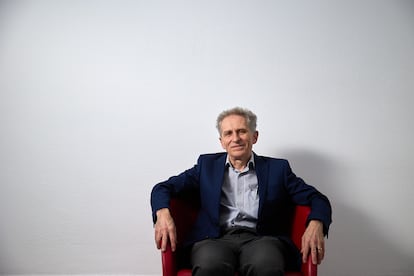Toward insulin-free Type 1 diabetes: New treatments that may slow down the disease
The European Medicines Agency is considering approving the first drug that has been shown to delay the onset of symptoms

Samuel was just four years old when he started behaving differently in November 2012. He wouldn’t stay still, he got thinner and was thirsty all day long. “He could drink a big bottle of water in one gulp. He drank so much that he started wetting his bed,” his mother, Maria Rego, remembers. Two months later, the boy was hospitalized. After many sleepless nights and several visits to the pediatrician, a glucose test result of 400 — normal is between 70 and 120 — revealed what was wrong. “The child had Type 1 diabetes. We finally understood everything, but it was still a shock, a life-changing moment,” Rego says.
Like Samuel, around 100,000 Spaniards live with this disease, in which the body runs out of insulin because the immune system destroys the beta cells that produce it in the pancreas. Thus, the patient must adopt strict routines to control blood glucose levels and inject the right doses of insulin for the rest of their life. Unlike Type 2 diabetes, which develops at a later age and is associated with obesity and a sedentary lifestyle, Type 1 diabetes is usually diagnosed in childhood and adolescence.
For more than a century — since Frederick Banting discovered the hormone in 1921 and succeeded in turning a fatal disease into a chronic one — medicine has treated Type 1 diabetes as a metabolic ailment. The goal in managing it is to make up for the lack of insulin with injections. But that is beginning to change thanks to new treatments that seek to prevent the disease from ever developing in the first place. “We are taking the first steps toward insulin-free Type 1 diabetes. And this is a transcendental idea,” says Colin Dayan, an international expert in the disease.
Teplizumab, the active ingredient marketed under the brand name Tzield, is the name of the first such therapy proven to be safe and effective. “The drug prevents T lymphocytes from attacking beta cells and slows down the disease’s progression for two to three years. That is important because it frees patients, who are usually children and adolescents, from having to take insulin daily during that time. But even more important is that it can be the first step in delaying Type 1 diabetes until it is done indefinitely,” explains Spanish immunologist Francisco León, whose research in the United States demonstrated the drug’s safety and efficacy.
Tzield was approved in the U.S. in November 2022 and the European Medicines Agency (EMA) is now studying whether to do the same in the EU. During this time, the company with which León developed the drug — ProventionBio — was bought by pharmaceutical giant Sanofi for over €2.7 billion ($2.8 billion). “We are now evaluating whether teplizumab is also effective after the onset of diabetes. The first results show that it can protect still-functioning beta cells in the pancreas, which could improve the prognosis and reduce the need for insulin. But we need to better understand these promising results,” says José Luis Guallar, medical director of Sanofi in Spain.

This immunotherapy is the first of all medical strategies for tackling the causes of Type 1 diabetes that has had some success, says Antonio Pérez, the president of the Spanish Diabetes Society (SED). “For decades, we have been investigating what triggers the immune system’s attack against beta cells. We know there is a genetic predisposition, but only one in 10 people who have it will eventually develop the disease. So, there must be something that sets the process in motion, but we still don’t know what it is,” he says.
One of the main hypotheses is that some viral infections trigger the immune system’s overreaction. Researchers from the Agency for Quality and Health Assessment of Catalonia (AQUAS) and the Hospital del Mar (Barcelona, Spain) discovered that the incidence of the disease in Spain soared during the pandemic. The same trend has also been observed in other countries, which points to the coronavirus as the cause. With money from Sanofi, Francisco León started another study on a virus called coxsackievirus B. “It is the only one that has shown a statistically significant association with Type 1 diabetes in the two largest studies conducted, TEDDY and DIPP, with over 600,000 subjects studied. This association has been observed in 15 countries,” he says.
Transplantation of pancreatic islets containing beta cells has been another gamble that has been unsuccessful so far. “It has been done, but the immune system destroys them again. To avoid that, we would have to subject the patient to immunosuppressive treatment equivalent to that of a person receiving a liver, for example. And that has risks. It is justified when there are no life-saving alternatives for the patient, but not with diabetes, which can be treated with insulin,” Perez says.
The new strategy emerging with teplizumab — along with nine other molecules under investigation — is a total game changer, Dayan enthuses. “If all the trials are successful, we can perform selective immunosuppression, without the risk of serious infections. And we can adopt an approach that is already being used for other autoimmune diseases, such as rheumatoid arthritis: combining different drugs and adapting the necessary ones to the patient’s progress,” he says. This selective immunosuppression would also make pancreatic islet transplantation viable: “The new drugs would protect the transplanted beta cells safely,” the expert adds.
However, the potential of teplizumab and other treatments under development currently faces a major obstacle: how do we know who needs to be treated? Medicine has the tools to know which people will develop Type 1 diabetes: tests that detect antibodies in the blood that reveal that the process that will destroy the beta cells is already underway, even if the patient does not yet have any symptoms.
Samuel has a twin brother, Marcos, and a 12-year-old younger sister. “Neither of them have had these tests done. Sometimes I wonder if it would be worth doing it, that maybe it is better to know beforehand what is coming, but the truth is that the doctors are right when they say that there is no reason to do them and that they are not [clinically] indicated. Why suffer if there is no treatment that can help them? If the EMA approves teplizumab, then yes, there would be a reason to do them,” their mother says.
Immediate family members of a patient with Type 1 diabetes are at 10 times greater risk of developing the disease than the general population. “The logical thing would be to start screening these people. The problem is that 90% of diagnoses occur in people with no family history, so this strategy would only allow us to detect a minimal portion of the cases,” explains Pérez.
Dayan believes that in order to overcome this problem, it would be necessary to universalize screening in children, starting with an initial test at three or four years old, which would allow up to 70% of potential cases to be detected. “It may well be necessary to repeat it at eight or nine years of age to identify minors in whom the autoimmune process has started later, although there is still a lot of debate about that. It is a simple test that can be done with a finger prick; it costs about €20 [$21] and could be managed by the child’s physician, as he or she already does with vaccines,” he argues.
But the SED president is more cautious. “There is no country where this is established. We have to consider the costs, the price of the treatment, the management of the tests and all the impact it would have on the healthcare system. And if the responsibility falls on pediatricians, it would overload primary care even more,” Pérez notes. In Spain, a dozen scientific associations have set up a working group to assess the best strategy to follow in view of teplizumab’s possible approval by the EMA.
While waiting for medical advances, the patients’ families are excited. “Living with Type 1 diabetes at home is very complicated. With a child, you have to measure everything. What they do, what they eat, what they inject. Every day. The new smart devices that calculate glucose levels and administer the necessary insulin have been great progress, but a scenario in which patients do not need it seems like a dream today,” says Rego, who is also the president of an association of patients with the disease in Galicia, Spain (ANEDIA).
Sign up for our weekly newsletter to get more English-language news coverage from EL PAÍS USA Edition









































